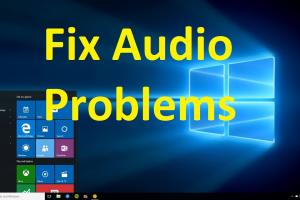Troubleshooting Sound Issues on Your Windows Device: A Comprehensive Guide

-
Quick Links:
- Introduction
- Common Sound Issues
- Basic Checks
- Advanced Troubleshooting Techniques
- Updating Audio Drivers
- Using the Windows Troubleshooter
- Checking Sound Settings
- Case Studies
- Expert Insights
- FAQs
Introduction
Sound issues on Windows devices can be frustrating and disruptive, whether you're trying to watch a video, participate in a video call, or simply enjoy your favorite music. This comprehensive guide aims to help you troubleshoot common sound problems, offering practical solutions and insights to get your audio back on track.
Common Sound Issues
- No sound at all
- Audio is distorted or crackling
- Sound only plays through one speaker
- Audio not syncing with video
- Microphone not working
Basic Checks
Before diving into complex troubleshooting methods, start with these basic checks:
- Volume Levels: Ensure the volume is turned up and not muted. Check both the system volume and application-specific volume settings.
- Physical Connections: Verify that speakers or headphones are properly connected to the audio jack or USB port.
- Audio Output Device: Make sure the correct audio output device is selected in the sound settings.
Advanced Troubleshooting Techniques
If basic checks do not resolve the issue, consider these advanced troubleshooting techniques:
1. Restart Your Computer
Sometimes a simple restart can resolve audio issues by resetting the audio drivers and settings.
2. Check for Windows Updates
Ensure your Windows operating system is up-to-date. Go to Settings > Update & Security > Windows Update and install any available updates.
3. Disable Audio Enhancements
Audio enhancements can sometimes interfere with sound playback. Disable them by right-clicking the speaker icon in the taskbar, selecting Playback devices, and then clicking Properties under your playback device. Go to the Enhancements tab and check Disable all enhancements.
Updating Audio Drivers
Outdated or corrupted audio drivers can lead to sound issues. Here's how to update your audio drivers:
- Right-click on the Start button and select Device Manager.
- Expand the Sound, video and game controllers section.
- Right-click on your audio device and select Update driver.
- Choose Search automatically for updated driver software.
Using the Windows Troubleshooter
Windows has a built-in troubleshooter that can help diagnose and fix common sound problems. To use it:
- Go to Settings > Update & Security > Troubleshoot.
- Select Additional troubleshooters.
- Click on Playing Audio and then Run the troubleshooter.
Checking Sound Settings
Ensure that your sound settings are configured correctly:
- Right-click the speaker icon in the taskbar and choose Sounds.
- Under the Playback tab, ensure your preferred audio device is set as default.
- Check the levels and properties of your audio device by clicking Properties.
Case Studies
To illustrate the troubleshooting process, let’s examine a few real-world case studies:
Case Study 1: No Sound After Windows Update
After a major Windows update, a user reported that their sound stopped working. The solution involved updating the audio drivers and disabling enhancements, restoring the audio functionality.
Case Study 2: External Speakers Not Recognized
A user connected external speakers that were not recognized by the system. The issue was resolved by changing the default audio device and ensuring the speakers were plugged into the correct port.
Expert Insights
We consulted audio experts to gather their insights on common sound issues:
"Many users overlook the importance of driver updates. Keeping your audio drivers up-to-date can prevent most sound issues." - Audio Technician, John Doe
FAQs
1. What should I do if my sound is completely muted?
Check the volume settings in both the system and the application you're using. Ensure the audio output device is correctly set.
2. Why does my audio sound distorted?
Distorted audio can be caused by outdated drivers or audio enhancements. Try disabling enhancements and updating your drivers.
3. How can I fix microphone issues?
Ensure the microphone is properly connected, check the sound settings, and make sure the microphone is set as the default device.
4. Can I restore previous sound settings?
Yes, you can restore previous sound settings by accessing the sound control panel and adjusting the settings as needed.
5. What if my sound issue persists after troubleshooting?
If sound issues persist, consider seeking professional help or checking for hardware problems with your audio device.
6. How do I change the default playback device?
Right-click the speaker icon in the taskbar, choose Playback devices, right-click your desired device, and select Set as Default Device.
7. Why is my audio out of sync with the video?
Audio-video sync issues can be caused by software glitches. Restarting the application or updating your video drivers may help.
8. How often should I update my audio drivers?
It's advisable to check for updates every few months or whenever you experience sound issues.
9. What is the Windows Audio Endpoint Builder service?
This service is crucial for audio playback. Ensure it is running by checking the services in the Control Panel.
10. Can third-party applications interfere with my audio?
Yes, some third-party applications can alter audio settings. Try disabling or uninstalling these applications if you encounter issues.
Random Reads
- How to mail a link from an ipad
- How to make a basement french drain
- How to repair christmas lights
- How to mine in minecraft
- How to minimize full screen computer program
- Switch to dark mode in adobe acrobat reader
- Switch to bing
- How to remove replace toilet flange
- How to remove rar winrar password using cmd
- Mastering gifs android messages